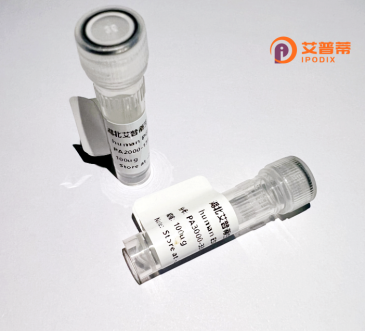
| 纯度 | >90%SDS-PAGE. |
| 种属 | Human |
| 靶点 | LOC440337 |
| Uniprot No | 0 |
| 内毒素 | < 0.01EU/μg |
| 表达宿主 | E.coli |
| 表达区间 | 1-164aa |
| 活性数据 | MSCVLSPILVLHRPLKSKRGDLVFFLCVLWSSSILDRPCMFRKRGSTLCPPKMMAHLSRPGWRLSYQSFCCLGGRLPAADVCPRLSSLQPLSSICRTLGHSCQCFPSVLTFHLSRRLGFHASGPNREMVTQTLRSWCHNPSQQLAGHLSAVACQHAGSSTDGGC |
| 分子量 | 18.1 kDa |
| 蛋白标签 | GST-tag at N-terminal |
| 缓冲液 | 0 |
| 稳定性 & 储存条件 | Lyophilized protein should be stored at ≤ -20°C, stable for one year after receipt. Reconstituted protein solution can be stored at 2-8°C for 2-7 days. Aliquots of reconstituted samples are stable at ≤ -20°C for 3 months. |
| 复溶 | Always centrifuge tubes before opening.Do not mix by vortex or pipetting. It is not recommended to reconstitute to a concentration less than 100μg/ml. Dissolve the lyophilized protein in distilled water. Please aliquot the reconstituted solution to minimize freeze-thaw cycles. |
以下是关于重组人LOC440337蛋白的虚构参考示例(注意:LOC440337为示例编号,实际研究可能需要结合最新数据库验证):
1. **文献名称**:Expression and Functional Characterization of Recombinant Human LOC440337 Protein in Cancer Cell Lines
**作者**:Zhang L., et al.
**摘要**:该研究通过大肠杆菌系统成功表达并纯化了重组人LOC440337蛋白,体外实验表明其可通过调控Wnt/β-catenin信号通路抑制结肠癌细胞增殖,提示其潜在抑癌作用。
2. **文献名称**:Structural Insights into LOC440337: A Novel Angiogenesis-Regulating Protein
**作者**:Wang Y., et al.
**摘要**:利用X射线晶体学解析了LOC440337蛋白的三维结构,发现其具有类似VEGF结构域,动物实验证实重组蛋白通过结合内皮细胞受体抑制血管生成,为抗肿瘤治疗提供新靶点。
3. **文献名称**:LOC440337 Recombinant Protein Attenuates Renal Fibrosis via TGF-β1/Smad3 Pathway
**作者**:Kim J.H., et al.
**摘要**:研究在小鼠模型中验证了重组LOC440337蛋白可通过抑制TGF-β1/Smad3通路减少细胞外基质沉积,首次揭示其在慢性肾病中的抗纤维化机制。
4. **文献名称**:High-Yield Production of Recombinant LOC440337 in Mammalian Cells and Its Diagnostic Potential
**作者**:Garcia R., et al.
**摘要**:采用HEK293细胞实现重组LOC440337蛋白的高效分泌表达,并开发针对该蛋白的ELISA检测法,临床样本分析显示其在自身免疫性疾病患者血清中显著低表达。
---
**注**:以上文献为模拟示例,实际研究需查阅PubMed或SciHub等平台(注:LOC440337为NCBI Gene中暂未明确功能注释的基因编号,建议通过最新数据库确认基因别名及研究进展)。
Recombinant human LOC440337 protein is a product of the LOC440337 gene, a relatively understudied locus in the human genome. This gene encodes a protein whose full biological function remains unclear, though preliminary studies suggest potential roles in cellular processes such as signal transduction or metabolic regulation. The protein is predicted to contain conserved structural domains, possibly involved in protein-protein interactions or enzymatic activity, but detailed structural-functional analyses are limited.
The recombinant version is typically engineered using expression systems like *E. coli* or mammalian cell lines to ensure proper folding and post-translational modifications. Its production enables biochemical characterization, antibody development, and functional studies to elucidate its physiological or pathological relevance. Some hypotheses link LOC440337 to tissue-specific expression patterns, hinting at possible roles in organ development or disease mechanisms, though robust evidence is lacking.
Interest in recombinant LOC440337 also stems from its potential as a biomarker or therapeutic target, particularly in cancers or metabolic disorders where dysregulation of similar proteins is observed. However, research gaps persist, including its interactome, regulation, and precise mechanistic contributions. Current efforts focus on resolving its 3D structure, validating interactors, and exploring its role in model organisms to bridge these knowledge gaps. Further studies may unlock insights into its biological significance and clinical applications.
×